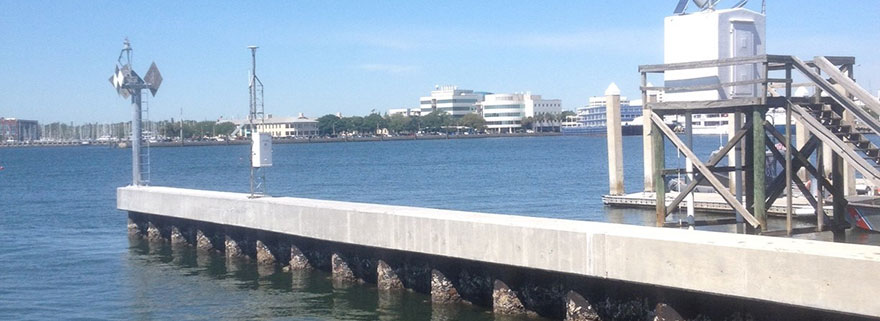Top: Data from the St. Petersburg tidal gauge, online since 1946, was incorporated into international projections to create locally adjusted predictions for the region. Photo courtesy National Oceanic and Atmospheric Administration.”
The Tampa Bay Regional Planning Council has accepted recommendations on sea level rise endorsed by a group of the area’s most prominent scientists and resource managers to be used in planning for infrastructure investment and adaptation strategies.
The goal was to provide affected governments in the region with the best possible research for their communities,” said Maya Burke, senior environmental planner for the TBRPC. “Some cities and counties are already considering how to address sea level rise, while others have not taken those steps. Having a clear set of recommendations for the region means we’re all playing from the same book.”
The Tampa Bay Climate Science Advisory Panel (CSAP) projections, based on a 2014 National Climate Assessment include four scenarios that have been adjusted for local conditions. Current scenarios through 2100 call for:
- NOAA Low (0.93 feet) continues the historic sea level rise documented over the past 70 years, but scientists warn that it should be used only as a baseline comparison or in circumstances where there is greater tolerance for risk.
- NOAA Intermediate Low (1.97 feet) accounts primarily for sea level rise created when increasing temperatures cause waters to expand.
- NOAA Intermediate High (4.26 feet) is an attempt to characterize the complex relationships between observed sea level change, air temperature and actual ice sheet loss.
- NOAA High (6.89 feet) combines the impact of ocean warming and the maximum anticipated glacier and ice sheet loss by the end of the century.
“It’s impossible to predict actual sea level rise within those ranges but we encourage local governments to consider the tolerable level of risk for each project and apply the most appropriate scenarios as they make recommendations,” notes Libby Carnahan, CSAP facilitator and Florida Sea Grant agent for Pinellas County.

Making wise decisions about those options will be challenging, Carnahan adds. “On one hand, you have to weigh the economic costs of inaction – including flooding of roads, homes, hospitals and power plants – against the costs of implementing adaptation strategies and infrastructure investments. However, there are viable opportunities for increasing our resilience to sea level rise, particularly if we work together as a region to protect public safety, health and quality of life.”
Established in early 2014, the CSAP reviewed multiple projections from national and international agencies before choosing the NOAA data, then recommended that it be “regionally corrected” using the St. Petersburg tide gauge. The NOAA projections are consistent with international projections as well as the older National Research Council predictions from the 1980s. They also integrate with free decision-support tools, including one developed by the U.S. Army Corps of Engineers, and are updated about every five years.
Incorporating the most recent research is critical, adds Dr. Gary Mitchum, a professor of oceanography at the University of South Florida’s College of Marine Science who also serves on the executive board of the Florida Climate Institute. “The earlier we see the rate of change increasing, the more potential for increased sea level rise over the long term,” he notes. Data from gauges around the world, including the St. Petersburg gauge, suggest the sea level rise might be speeding up, jumping from about two millimeters a year from 1950 to 1992 to three millimeters over the last two decades, he said.
The St. Petersburg tidal gauge has the longest history in the region and shows that water levels have increased approximately 6.6 inches over the last 70 years. It helps scientists adjust for local conditions, including vertical land motion, changes in estuarine and shelf hydrodynamics as well as oceanographic and hydrological cycles.
“Even with the variability in predicted increases, we can make plans that will ensure that our region has the resiliency it needs to remain economically vibrant and ecologically valuable – as long as we act now and make the right decisions for future generations,” Burke said.
Learn more:
The entire CSAP report is online.
The Department of Homeland Security recently held a program on resiliency that challenged local planners and elected officials to spend a limited budget protecting critical infrastructure. Read the story.
